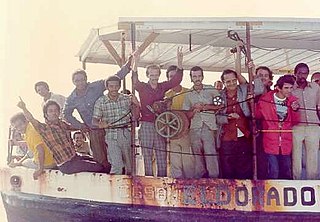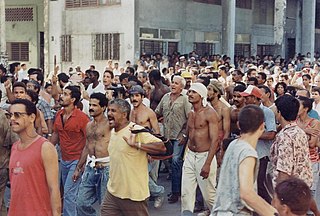
Operation Peter Pan was a clandestine exodus of over 14,000 unaccompanied Cuban minors ages 6 to 18 to the United States over a two-year span from 1960 to 1962. They were sent by parents who feared, on the basis of unsubstantiated rumors, that Fidel Castro and the Communist party were planning to terminate parental rights and place minors in alleged "communist indoctrination centers", commonly referred to as the Patria Potestad. No such actions by the Castro regime ever took place.

The Mariel boatlift was a mass emigration of Cubans who traveled from Cuba's Mariel Harbor to the United States between April 15 and October 31, 1980. The term "Marielito" is used to refer to these refugees in both Spanish and English. While the exodus was triggered by a sharp downturn in the Cuban economy, it followed on the heels of generations of Cubans who had immigrated to the United States in the preceding decades.

Cuban Americans are Americans who immigrated from or are descended from immigrants from Cuba. As of 2023, Cuban Americans were the fourth largest Hispanic and Latino American group in the United States after Mexican Americans, Stateside Puerto Ricans and Salvadoran Americans.

The Maleconazo was a protest on 5 August 1994, in which thousands of Cubans took to the streets around the Malecón in Havana to demand freedom and express frustration with the government. Following the collapse of the Soviet Union in the early 1990s, Cuba fell into a crippling economic crisis that had many citizens looking to flee the island. On the day of the protest, the Cuban police blocked people from boarding tugboats leaving Havana, prompting thousands of citizens to storm the streets in the largest anti-government demonstration Cuba had seen since the Cuban Revolution. In the following weeks, President Fidel Castro quelled the frustration by opening the doors of the country and allowing Cubans to leave, which had a significant impact on Cuba's relationship with the United States moving forward.
Dr. Bernardo Benes Baikowitz was a prominent Jewish Cuban lawyer, banker, journalist and civic leader, who was responsible for freeing 3,600 Cuban political prisoners in 1978.
Clark v. Martinez, 543 U.S. 371 (2005), was a United States Supreme Court case ending the detention of people who had been denied refugee status. They were kept in prison awaiting deportation even though they could not in fact be deported due to a political stalemate with Cuba. An alien can be found inadmissible on the grounds of poor health, criminal history, substance trafficking, prostitution/human trafficking, money laundering, terrorist activity, etc. The deportation process requires a ruling from an immigration judge for violating immigration laws. The case resolved conflicting rulings made by the 9th and 11th circuits on whether Zadvydas v. Davis (2001) was applicable to inadmissible immigrants, Sergio Martinez and Daniel Benitez. The cases of Martinez and Benitez were later consolidated by the Supreme Court.
Victor Andres Triay is a Cuban American historian and writer, known for the books Fleeing Castro: Operation Pedro Pan and the Cuban Children’s Program, Bay of Pigs: An Oral History of Brigade 2506, The Unbroken Circle, and The Mariel Boatlift: A Cuban American Journey.
Marielitos is the name given to the Cuban immigrants that left Cuba from the Port of Mariel in 1980. Approximately 135,000 people left the country to the United States from April to September in what became known as the Mariel boatlift.

Freedom Flights transported Cubans to Miami twice daily, five times per week from 1965 to 1973. Its budget was about $12 million and it brought an estimated 300,000 refugees, making it the "largest airborne refugee operation in American history." The Freedom Flights were an important and unusual chapter of cooperation in the history of Cuban-American foreign relations, which is otherwise characterized by mutual distrust. The program changed the ethnic makeup of Miami and fueled the growth of the Cuban-American enclave there.

Cuban immigration to the United States, for the most part, occurred in two periods: the first series of immigration of wealthy Cuban Americans to the United States resulted from Cubans establishing cigar factories in Tampa and from attempts to overthrow Spanish colonial rule by the movement led by José Martí, the second to escape from Communist rule under Fidel Castro following the Cuban Revolution. Massive Cuban migration to Miami during the second series led to major demographic and cultural changes in Miami. There was also economic emigration, particularly during the Great Depression in the 1930s. As of 2019, there were 1,359,990 Cubans in the United States.

The 1994 Cuban rafter crisis which is also known as the 1994 Cuban raft exodus or the Balsero crisis was the emigration of more than 35,069 Cubans to the United States. The exodus occurred over five weeks following rioting in Cuba; Fidel Castro announced in response that anyone who wished to leave the country could do so without any hindrance. Fearing a major exodus, the Clinton administration would mandate that all rafters captured at sea be detained at the Guantanamo Bay Naval Base.
"Refugees as weapons" is a term used to describe a hostile government organizing, or threatening to organize, a sudden influx of refugees into another country or political entity with the intent of causing political disturbances in that entity. The responsible country usually seeks to extract concessions from the targeted country and achieve some political, military, and/or economic objective.

The emigration of Cubans, from the 1959 Cuban Revolution to October of 1962, has been dubbed the Golden exile and the first emigration wave in the greater Cuban exile. The exodus was referred to as the "Golden exile" because of the mainly upper and middle class character of the emigrants. After the success of the revolution various Cubans who had allied themselves or worked with the overthrown Batista regime fled the country. Later as the Fidel Castro government began nationalizing industries many Cuban professionals would flee the island. This period of the Cuban exile is also referred to as the Historical exile, mainly by those who emigrated during this period.

Haitian boat people are refugees from Haiti who flee the country by boat, usually to South Florida and sometimes the Bahamas.

The Cuban success story, sometimes referred to as the myth of the golden exile, is the idea that Cuban exiles that came to the United States after the 1959 Cuban Revolution were mostly or exclusively political exiles who were white, largely conservative, and financially successful. The idea garnered traction starting in the 1960s via rags-to-riches stories of Cuban exiles in the US news media, and became widely promoted within the Cuban American community. The idea has been criticized as an inaccurate depiction of Cuban Americans that ignores historical fact.

A dialoguero is a label for a person who wants to open negotiations with the Cuban government. The label was coined as an epithet by hard-line anti-communist Cuban exiles.

In 1978 negotiations known as El Diálogo occurred between Cuban exile groups and the Cuban government that resulted in the release of political prisoners.

A Cuban exile is a person who emigrated from Cuba in the Cuban exodus. Exiles have various differing experiences as emigrants depending on when they migrated during the exodus.

Cuban boat people mainly refers to refugees who flee Cuba by boat and ship to the United States. There have been four distinct waves of immigration, both legal and illegal, from Cuba to the United States. These four waves include early boat arrivals, the marielitos, the balseros, and the post “Wet foot, dry foot” arrivals. These waves can be attributed to specific periods in Cuba’s socioeconomic decline and stages in Cuban-U.S. relations. Since the 1960s, the process by which balseros would immigrate would become increasingly difficult and dangerous leading to a variety of controversy, both legislative and humanitarian.

On April 1, 1980, six Cuban citizens made their way into the Peruvian embassy in Havana, Cuba, instigating an international crisis over the diplomatic status of around 10,000 asylum-seeking Cubans who joined them over the following days. The Peruvian ambassador, Ernesto Pinto Bazurco Rittler, spearheaded the effort to protect Cubans, most of whom were disapproved of by Fidel Castro’s regime and were seeking protection at the embassy. This episode marked the start of the Cuban refugee crisis, which was followed by a series of diplomatic initiatives between various countries in both North and South America that tried to organize the fleeing of people from the island of Cuba to the United States and elsewhere. The embassy crisis culminated with the substantial exodus of 125,266 Cuban asylum-seekers during the Mariel Boatlift.






















